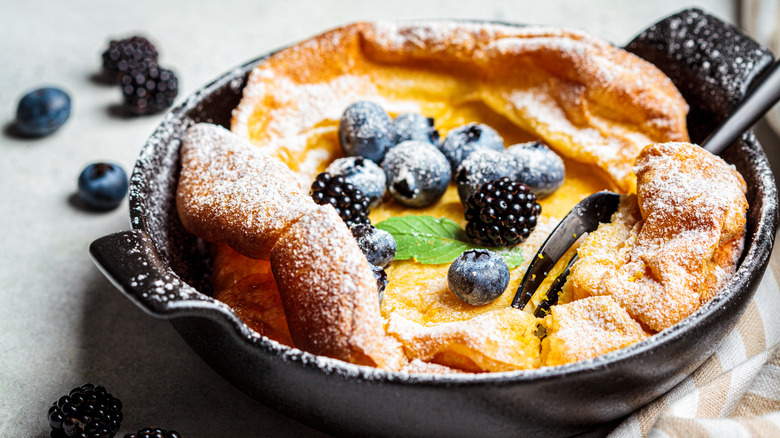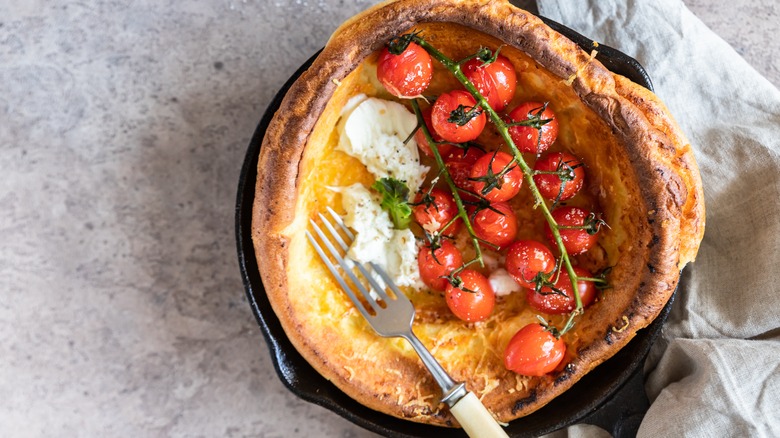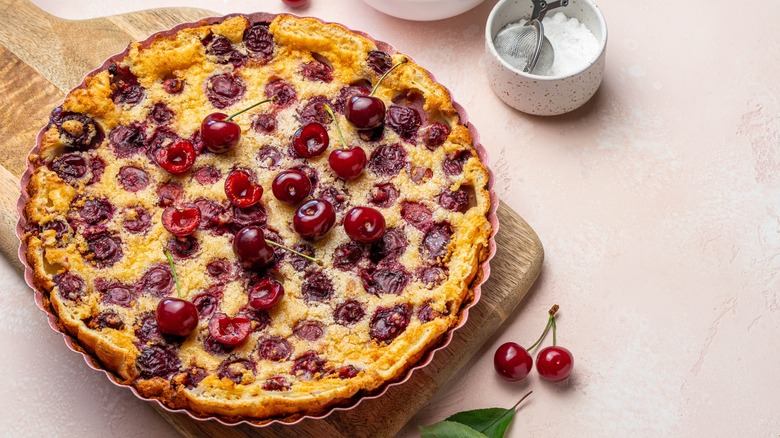Dutch Baby Vs Clafoutis: What's The Difference?
Cooking is a transformative practice. Some basic ingredients are taken and, through mixing, whipping, boiling, or baking, are turned into something entirely different. The method and measurements are crucial, too, because the ratios and recipes you choose can turn something as simple as bread and eggs into either French toast or an egg salad sandwich (give or take a few ingredients). A clafoutis and a Dutch baby aren't quite as different from each other as an eggy breakfast is from an eggy lunch — but the principle still applies.
Clafoutis and Dutch babies both begin with a batter. That batter includes eggs, sugar, milk, flour, and vanilla — both dishes often include some kind of fruit, too. They're both worth taking the time to whip up separately, though, because once you begin to mix the batters together and finally take the dishes out of the oven, a clafoutis will emerge a fluffy, light custard, and a Dutch baby will become a crispy-edged pancake.
A puffed pancake that isn't really Dutch
A Dutch baby isn't exactly a pancake, but the method for making it probably seems similar at the start. Instead of flipping circles of batter in a pan on the stovetop, though, you cook the Dutch baby by pouring all the batter into butter-lined cast iron and baking it in the oven. Even though the batter starts off pretty runny, it will puff up like a soufflé as it bakes, then collapse when it's removed from the oven. You want to make sure your Dutch baby has perfectly crisp, browned edges and a soft, fluffy interior. At that point, you can top it with powdered sugar and fruit to make something sweet, like a triple berry Dutch baby, or you can opt for savory additions like herbs and caramelized onions.
Most likely, the Dutch baby is actually descended from the German pfannkuchen (their word for "pancake"). Its name is popularly credited to the daughter of the owner of Manca's, a cafe in Seattle that started serving the pancakes back in the early 1900s. It's said that she mispronounced "Deutsch" as "Dutch," and the name stuck.
Clafoutis comes out a custard
A clafoutis, on the other hand, traces its origins to Limousin, a rural area of central France, at least as far back as the mid-19th century. Rather than a pancake, a clafoutis is more like a flan or a tart. The batter is also thin but uses more eggs and sugar than a Dutch baby and is whisked rapidly until it's fluffy (or you can use a blender hack for the dreamiest clafoutis). Rather than topping it with fruit after it's baked (as you do with the Dutch baby), the fruit is layered into the batter after you've poured it into the dish and before you stick it in the oven. Traditionally, the clafoutis uses pitted black cherries, but there's no need to be constrained by tradition. Use the fruits you like — like a clafoutis with summer berries, pears, or apricots. Savory is also an option for clafoutis if you'd rather mix in ingredients like tomatoes, cheese, or meat.
If you like cast iron pans, you can use one to bake clafoutis, but it's traditionally made in a ceramic pan or dish. Once cooked, the clafoutis will be a creamy, light custard infused with the fresh flavor of fruit. So, despite being made with the same ingredients, the texture and taste of Dutch babys and clafoutis will differ, but either dish will yield something delicious.


